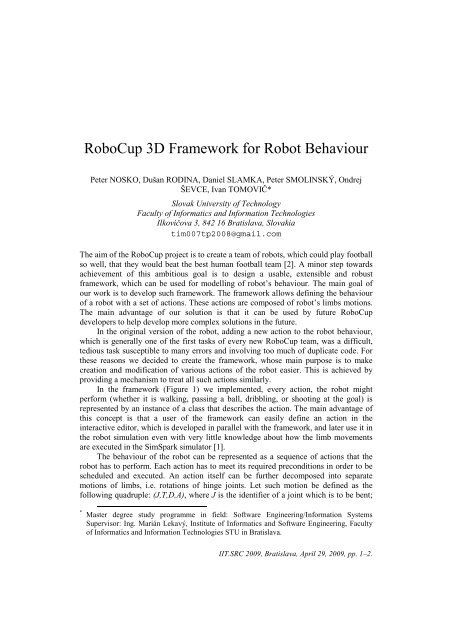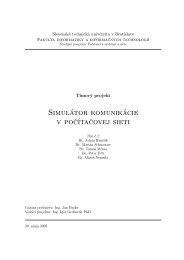RoboCup 3D Framework for Robot Behaviour
RoboCup 3D Framework for Robot Behaviour
RoboCup 3D Framework for Robot Behaviour
Create successful ePaper yourself
Turn your PDF publications into a flip-book with our unique Google optimized e-Paper software.
<strong>RoboCup</strong> <strong>3D</strong> <strong>Framework</strong> <strong>for</strong> <strong>Robot</strong> <strong>Behaviour</strong><br />
Peter NOSKO, Dušan RODINA, Daniel SLAMKA, Peter SMOLINSKÝ, Ondrej<br />
ŠEVCE, Ivan TOMOVIČ*<br />
Slovak University of Technology<br />
Faculty of In<strong>for</strong>matics and In<strong>for</strong>mation Technologies<br />
Ilkovičova 3, 842 16 Bratislava, Slovakia<br />
tim007tp2008@gmail.com<br />
The aim of the <strong>RoboCup</strong> project is to create a team of robots, which could play football<br />
so well, that they would beat the best human football team [2]. A minor step towards<br />
achievement of this ambitious goal is to design a usable, extensible and robust<br />
framework, which can be used <strong>for</strong> modelling of robot’s behaviour. The main goal of<br />
our work is to develop such framework. The framework allows defining the behaviour<br />
of a robot with a set of actions. These actions are composed of robot’s limbs motions.<br />
The main advantage of our solution is that it can be used by future <strong>RoboCup</strong><br />
developers to help develop more complex solutions in the future.<br />
In the original version of the robot, adding a new action to the robot behaviour,<br />
which is generally one of the first tasks of every new <strong>RoboCup</strong> team, was a difficult,<br />
tedious task susceptible to many errors and involving too much of duplicate code. For<br />
these reasons we decided to create the framework, whose main purpose is to make<br />
creation and modification of various actions of the robot easier. This is achieved by<br />
providing a mechanism to treat all such actions similarly.<br />
In the framework (Figure 1) we implemented, every action, the robot might<br />
per<strong>for</strong>m (whether it is walking, passing a ball, dribbling, or shooting at the goal) is<br />
represented by an instance of a class that describes the action. The main advantage of<br />
this concept is that a user of the framework can easily define an action in the<br />
interactive editor, which is developed in parallel with the framework, and later use it in<br />
the robot simulation even with very little knowledge about how the limb movements<br />
are executed in the SimSpark simulator [1].<br />
The behaviour of the robot can be represented as a sequence of actions that the<br />
robot has to per<strong>for</strong>m. Each action has to meet its required preconditions in order to be<br />
scheduled and executed. An action itself can be further decomposed into separate<br />
motions of limbs, i.e. rotations of hinge joints. Let such motion be defined as the<br />
following quadruple: (J,T,D,A), where J is the identifier of a joint which is to be bent;<br />
* Master degree study programme in field: Software Engineering/In<strong>for</strong>mation Systems<br />
Supervisor: Ing. Marián Lekavý, Institute of In<strong>for</strong>matics and Software Engineering, Faculty<br />
of In<strong>for</strong>matics and In<strong>for</strong>mation Technologies STU in Bratislava.<br />
IIT.SRC 2009, Bratislava, April 29, 2009, pp. 1–2.
<strong>RoboCup</strong> <strong>3D</strong> <strong>Framework</strong> <strong>for</strong> <strong>Robot</strong> <strong>Behaviour</strong> 2<br />
T is the time elapsed since the execution of the action be<strong>for</strong>e the move is started; D<br />
represents the duration of the entire move and A stands <strong>for</strong> the angle of rotation. With<br />
motions defined this way, it is possible to represent an arbitrary action as a set of<br />
groups of motions, ordered according to their start time. A motion group can contain<br />
motions that are to be synchronized with respect to each other.<br />
Figure 1. <strong>RoboCup</strong> <strong>3D</strong> <strong>Framework</strong> <strong>for</strong> <strong>Robot</strong> <strong>Behaviour</strong><br />
Yet another of the most important features is that the actions that compose<br />
behaviours can be stored into a file and loaded by the robot when the need arises. The<br />
type of behaviour that the robot will con<strong>for</strong>m to will then be selected by the higher<br />
logic on the basis of the robot’s intentions, represented by predefined constants, and<br />
the fulfilment of behaviours’/actions’ preconditions.<br />
One of the problems, robot developers often have to cope with, is how to maintain<br />
the stability of the robot. It would be very frustrating if the robot kept falling down<br />
only because of small collisions or not-so-precise movements. That is why we propose<br />
a robot stability module, whose task is to balance the robot at the event that would<br />
otherwise lead to its fall. The idea is that the module will keep track of the momentum<br />
and the relative position against the stabilization points (usually the feet of the robot)<br />
of the robot’s centre of mass, and via preventive movements and action correction<br />
attempt to regain stability.<br />
Acknowledgement: This work was partially supported by the Institute of<br />
In<strong>for</strong>matics and Software Engineering, Faculty of In<strong>for</strong>matics and In<strong>for</strong>mation<br />
Technologies, Slovak University of Technology in Bratislava. We would like to thank<br />
Lukáš Dvonč <strong>for</strong> his valuable consultations regarding the robot stability physics.<br />
References<br />
[1] Boedecker, J., SimSpark User’s Manual (version 1.1), 2008, [Online; accessed<br />
November 8th, 2008]. Available at:<br />
http://labss2.fiit.stuba.sk/TeamProject/2007/team11is-si/download.html<br />
[2] The <strong>RoboCup</strong> Federation, Robocup, [Online; accessed February 20th, 2009],<br />
Available at: http://www.robocup.org/








